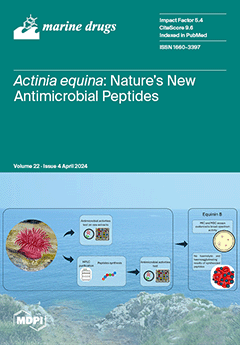Bacillus cereus, a common food-borne pathogen, forms biofilms and generates virulence factors through a quorum sensing (QS) mechanism. In this study, six compounds (dankasterone A, demethylincisterol A
3, zinnimidine, cyclo-(L-Val-L-Pro), cyclo-(L-Ile-L-Pro), and cyclo-(L-Leu-L-Pro)) were isolated from the endophytic fungus
Pithomyces sacchari
[...] Read more.
Bacillus cereus, a common food-borne pathogen, forms biofilms and generates virulence factors through a quorum sensing (QS) mechanism. In this study, six compounds (dankasterone A, demethylincisterol A
3, zinnimidine, cyclo-(L-Val-L-Pro), cyclo-(L-Ile-L-Pro), and cyclo-(L-Leu-L-Pro)) were isolated from the endophytic fungus
Pithomyces sacchari of the
Laurencia sp. in the South China Sea. Among them, demethylincisterol A
3, a sterol derivative, exhibited strong QS inhibitory activity against
B. cereus. The QS inhibitory activity of demethylincisterol A
3 was evaluated through experiments. The minimum inhibitory concentration (MIC) of demethylincisterol A
3 against
B. cereus was 6.25 μg/mL. At sub-MIC concentrations, it significantly decreased biofilm formation, hindered mobility, and diminished the production of protease and hemolysin activity. Moreover, RT-qPCR results demonstrated that demethylincisterol A
3 markedly inhibited the expression of QS-related genes (
plcR and
papR) in
B. cereus. The exposure to demethylincisterol A3 resulted in the downregulation of genes (
comER,
tasA,
rpoN,
sinR,
codY,
nheA,
hblD, and
cytK) associated with biofilm formation, mobility, and virulence factors. Hence, demethylincisterol A
3 is a potentially effective compound in the pipeline of innovative antimicrobial therapies.
Full article






